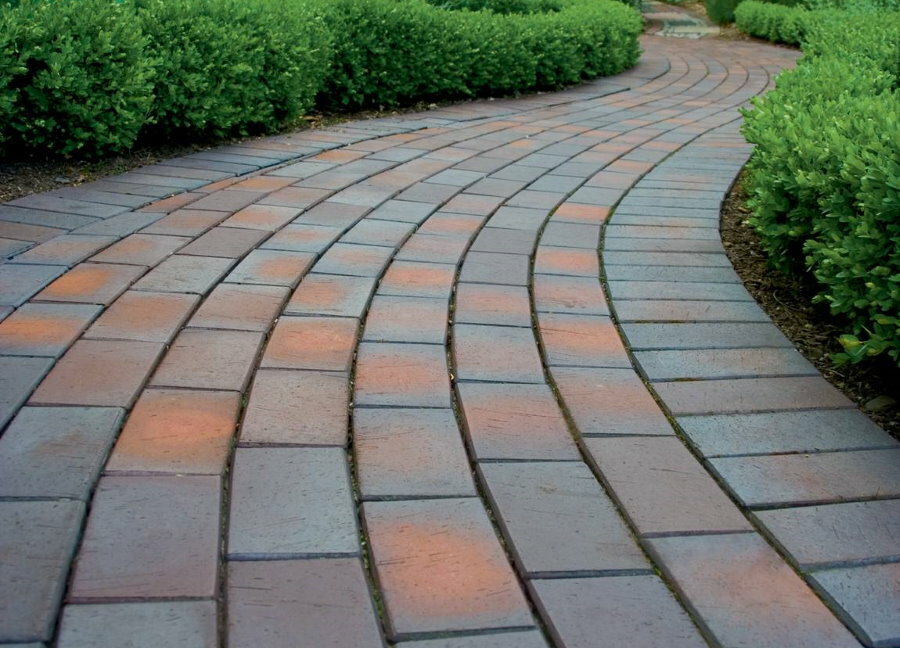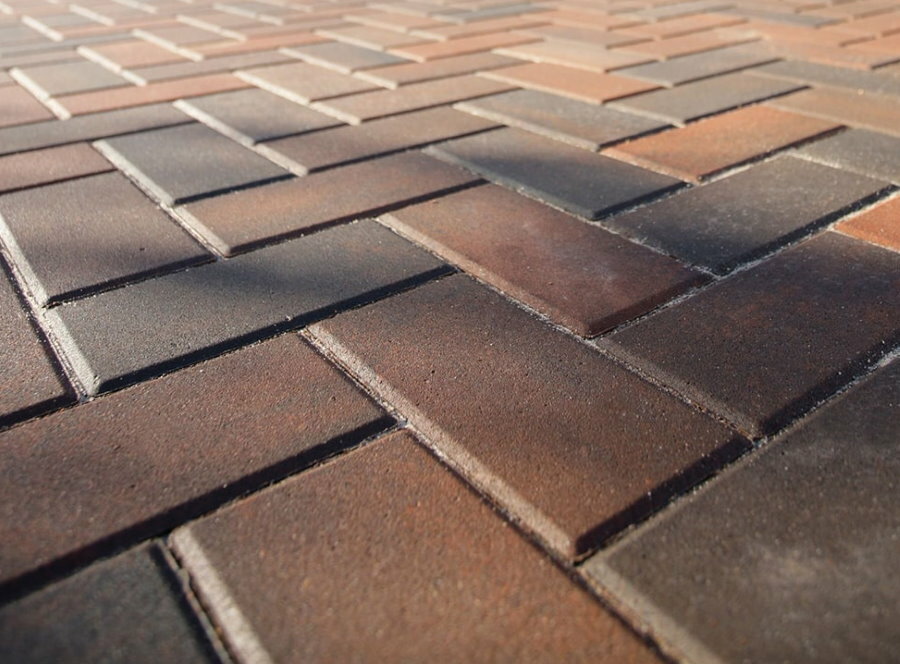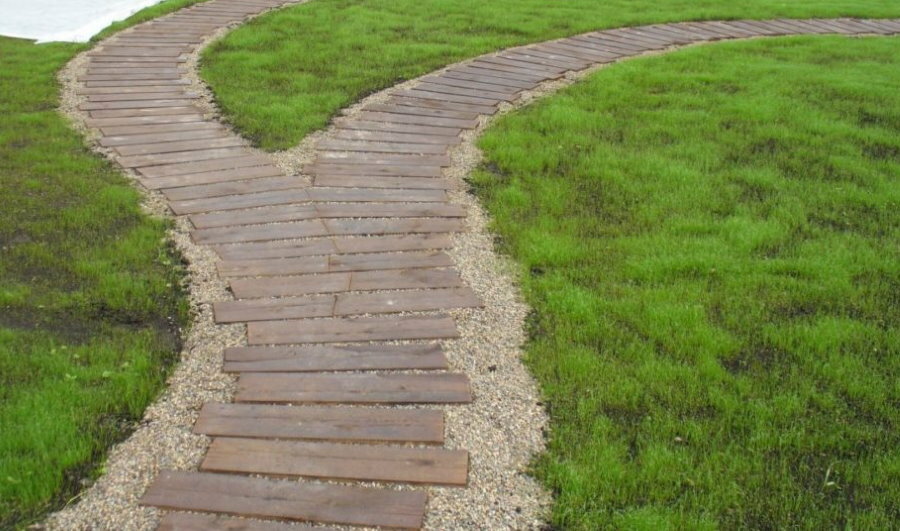It is difficult to imagine modern summer cottages and suburban areas without landscape design. People create cozy estates outside the city with flower beds, garden paths, lighting. When designing the aisles, take into account the layout of green spaces, the size of the site.

There is no doubt that garden paths decorate the site, but above all it is a matter of safety and cleanliness.
Gardening in landscape design - decorative paths
Content
- Gardening in landscape design - decorative paths
- Popular track materials
- Brick
- Crushed stone
- Plastic
- Gravel
- Paving stones
- Sandstone
- Pebbles
- Wood
- Rules and guidelines for choosing
- Video: Do-it-yourself garden path made of concrete under a stone
- Photos of finished beautiful tracks
Winding paths can visually enlarge the territory, straight paths can be extended in length, the type of coverage plays an important role. It can be inexpensive plastic garden flooring and natural stone. The review presents the most practical types of coatings used in temperate latitudes.
You can set the direction of movement with a drawing, and draw attention to the colors of the coatings.
Garden paths have long turned from commonplace passages to landscape decoration. They not only connect important objects, but also create a mood and atmosphere. A path or path in a garden is not necessarily the shortest distance between points A and B, a path 80 to 120 cm wide so that you can drive with a wheelbarrow. Narrow paths winding through the trees are designed for leisurely walks. Fantasy ones can surround a small artificial reservoir in a diverging spiral.

For the improvement of your site, you can choose any type of paths suitable for both decorative and household purposes
When arranging sidewalks, a slight slope is provided so that melt and rainwater does not accumulate. It is necessary to provide drainage, sand and gravel cushion, then in any weather it will be possible to avoid puddles. The pattern of paved surfaces is drawn in advance to maintain a uniform style of composition. With the help of color combinations, ornaments, they correct the visual perception of straight paths, they become not so primitive.

You can use different types of paths for each zone of the suburban area
Using zoning techniques, they change the width and direction of the paths, colors, and type of coverage. Applying the methods of narrowing and widening the tracks create the illusion of spaciousness in a small area. It is advisable to decorate the area with taste. Experiments are in trend, creativity is encouraged. It is important to express the individuality of each corner of the cottage or country estate.
Popular track materials
For the arrangement of central aisles, tiled materials are often chosen, for side ones, gravel, pebble. It should be pleasant to walk on surfaces, without the risk of slipping, staining shoes, wet feet.

The material for the garden path must be selected based on its purpose.
Practical, environmentally friendly materials deserve attention. For example, a garden covering in the form of boards or parquet modules of two types:
- from hard tree species (in the production process, the wood is compacted by pressing, covered with protective paintwork materials;
- budget option - decking materials based on organic resins with sawdust or wood flour content from 75 to 50%.

Garden parquet is represented by small boards with a pattern in the form of planks
The shape of the garden flooring is different:
- in the form of sections of a rectangular or square shape (parquet board);
- lamellas of various lengths and widths (deck board).

A deck board walkway is a deck raised above the ground
All types of coatings have good performance characteristics, when laying, the height of the supports is adjustable. Decking will easily hide small irregularities in the relief, and will last for a long time. Strong and durable material, easy to install. The only drawback is that in regions where winters are harsh, it is better to dismantle the flooring for safety for the winter so that the boards or shields do not suffer during the spring heaving of the soil.
Other types of coatings are often used to decorate the aisles. Each is worth mentioning separately.
Brick
Brick flooring is quite picturesque, especially when you combine several shades of building ceramics. For the paths, choose a solid masonry brick from the dismantled buildings of the beginning and middle of the past century or new clinker, with increased strength and moisture resistance due to low porosity. Hollow bricks are fragile, crumbling into dust under load, from the onslaught of ice.

For the device of garden paths, various types of bricks are used.
Clinker bricks are produced in the form of narrow tiles or standard bricks. The color depends on the type of clay, possible shades:
- red brown;
- classic terracotta;
- light gray when using lime-containing alumina;
- sandy color, this color is given by yellow types of clay.
Brick paths do not have to be decorated with a curb if the masonry is made on concrete mortar or special heat-resistant glue for masonry blocks. It is enough to make limiters from the board. The advantages of a brick garden path are undeniable: durable, beautiful coatings are obtained.

Curbs from the bricks themselves are the easiest way to form the boundaries of a brick path
When buying goods from the manufacturer, it is better to purchase substandard: burnout, bricks with small chips, shells. The cost of such products is much lower than that of varietal types of products.
Crushed stone
There are a lot of variations of crushed stone coatings. Coarse fractions are laid like paving stones on a sand cushion, resulting in a stone path with an anti-slip effect. Sharp edges are leveled with a sander. The voids are filled with sand. Paths made of crushed stone of medium and fine fraction are made in bulk between the limiters of the curb stone. Crushed stone is chosen only for side aisles, where there is no transport. When using several crushed rocks of different textures and colors, original versions of crushed stone paths in the country are obtained.

Bulk paths made of crushed stone - the easiest way to create paths for moving around a summer cottage
The coating has disadvantages: small pieces of stones are mobile, diverge underfoot. It is quite difficult to remove coniferous and leaf litter, garbage from the paths.

The convenience of walking on such a road depends on the size of the rubble
In general, this is an inexpensive option for paving winding passages, often used in modern landscaping.
Plastic
Polymers have excellent moisture resistance, do not rot from rain, and do not deteriorate from sub-zero temperatures. Plastic paths for summer cottages are made from ready-made panels of various shapes. In specialized departments, shopping centers, there is a large selection of tiles for the garden path. Manufacturers offer various colors and shapes.

Plastic walkway can be presented in the form of separate modules similar to cement paving slabs

Another option is a lawn grate, from which you can lay out a path between the beds or a platform for garden furniture.
Variants of modules of plastic paths with coloring pigments are best laid in shady areas where there is no direct sunlight. Not all paints are equally resistant to UV light, some fade quickly.
There are no special difficulties in installing coatings. The panels are stacked end-to-end on a sand cushion. Snap designs available. It is recommended to dismantle some types of plastic garden paths in regions where there are frosts below 30 degrees.
In the garden, equipping modular garden coverings between the beds, it is more convenient to use sawdust of tree species. In the spring, the rotted layer is used as a mulching substance.
Gravel
Inexpensive yet very scenic colored gravel paths will brighten any area. It is enough to align and tamp small pieces. For paths use:
- dense granite or marble, gabbro;
- expanded clay;
- shell rock;
- crushed pebble;
- rocks associated with minerals or precious stones.
The colors of the gravel paths are different from light yellow to terracotta, crushed marble of all kinds of shades looks especially decorative.

To prevent the path from creeping, it is advisable to fill the gravel between the fortified curbs

Gravel combines well with other materials - stone, wood or brick
For gravel paths in the garden, the trajectory is not important, it is easy to create winding narrow paths and straight passages to outbuildings.
When weeds appear, it is enough to spill the gravel with a herbicide solution or boiling water. Every 3-5 years, it is advisable to renew the pavement, add a new portion of gravel.
Paving stones
The main advantage of stone paths in the country is that paving is not afraid of mechanical damage, precipitation, and high loads. It is allowed to move on cobbled surfaces by transport. These types of coatings are ideal for decorating the front entrance.

The paving stone looks beautiful, is not afraid of moisture and can withstand loads
There are several types of paving tracks:
- Granite - the most reliable, is made for centuries. The material has high mechanical strength, withstands more than 100 freezing cycles, and is not afraid of temperature extremes. Paving retains its original aesthetic appearance for a long time, does not require constant maintenance. Granite paving stones are easy to sweep and can be washed with Körcher.

A platform or path, lined with granite paving stones, will serve for decades
- Clinker made of refractory clay becomes extremely strong after firing. It is used for driveways, design of recreation areas, small aisles. In terms of performance, it is comparable to natural stone, has low moisture absorption, and is frost-resistant. The color does not change under the influence of ultraviolet radiation, you can do multi-colored styling, make collage and mosaic compositions.

Clinker pavers have been produced since the 18th century and are the finest artificial paving materials available.
- Vibro-pressed is made from concrete mortar. Gravel, vegetable raw materials (chopped wood, sunflower husks, chopped straw) are used as fillers. Colorants are added to the molding mixture. Paving stones are characterized by the accuracy of geometric dimensions, the weight of the coatings, the surface texture depends on the type of filler.

Concrete paving stones are a budget coating option that is significantly inferior to those listed above in terms of service life.
The most popular are the cobblestone paths made of concrete and natural stone, striking in their decorativeness. The coating is easy to repair, replace one block with another. The paving stone is resistant to abrasion, is not washed away by melt and rainwater.
There are various techniques for laying paving stones: tape, with a shift in the seam, semicircle, and others. When laying, create original patterns.
Sandstone
For sandstone paths, a layered variety of natural stone is often used. The texture is determined by the size of the quartz grain. Although sandstone is not as strong as granite or marble, it is capable of absorbing water (it is filled up to 5% of its volume), and is appreciated for its decorative effect and roughness. On the sandstone path, you will not slip in rainy weather. Various styling options are possible. Natural stone from the category of detrital sedimentary rocks is mined in layers, for paving they acquire pieces of various formats, lay them out to fill the entire area of the path as much as possible.

Sandstone is laid on a concrete base or on sand, depending on the thickness of the stone
Manufacturers do not try to give the sandstone a certain look, they do not achieve perfect evenness of the edges. Chipped platinum with a thickness of 1 to 6 cm can be chipped, foreign inclusions. Landscape designers value the material for its unique structure and varied color. On sale you can find sandstone of white, bluish-blue, pink-red, green shades.
The voids between the plates can be filled with sand, fine gravel. Some people fill the space with cement-lime milk so that there are no weeds.
Pebbles
Natural material is not inferior in strength to continuous stone coatings. Decorative paths and pebble paths are appropriate in any corner of the garden. Natural stone will fit into any style. With a variety of shapes, sizes, colors, it is possible to create mosaic patterns, all kinds of patterns.

Recreation area paved with pebbles on a concrete base

A winding path covered with river pebbles
Despite the high cost, pebbles are traditionally used in landscape design:
- as a base coat;
- border decoration;
- additive to gravel or crushed stone.
By combining the natural colors of the pebbles, you can create real works of landscape art.
River pebbles are flatter, sea pebbles are rounded, not as smooth as river pebbles.
Wood
For the formation of garden paths, round cuts of trunks or hemp, chips and tes (boards of various formats) are used. The most durable wood is larch, and the second place is oak. For water-repellent treatment of wood, special impregnations are used so that the wood does not collapse from contact with the ground.

Garden path made of wood cuts impregnated with a protective compound

A path of thick planks laid on a gravel bed
Such paths are arranged in places with low traffic. The natural material is very beautiful and gives the garden a special comfort. The main disadvantage is the low service life. Drainage is made under the paths and paths of wood. Boards are installed on logs so that the path is ventilated. Chip mounds are watered with fungicide solutions, insecticides to avoid the spread of fungal infections, insect infestations.
To impregnate wood, use old drying oil or used engine oil.
Rules and guidelines for choosing
In climatic zones with high humidity, it is better to replace wood with modern wood-like materials. It is important to consider the roughness of the pavement to avoid injury when moving through dew. The service life of the tracks depends on the selection of materials. It is worth abandoning inexpensive concrete paving stones, it is recommended to mix smooth river pebbles with gravel.

Before laying tracks, you should think about their location.

The winding paths are inviting, but most people prefer to walk upright.
Wooden cuts are suitable for arranging fabulous paths, approaches to an artificial reservoir. The classic design option is clinker paving stones of straight or offset laying. Colored fine gravel looks great and is safe to drop accidentally.
Any paths should fulfill the main task - to provide access to any, even the most remote corners of the garden.
Video: Do-it-yourself garden path made of concrete under a stone
Photos of finished beautiful tracks
In a small selection of photographs, creative solutions for the design of the tracks are presented. Mosaics and collages made of stone or paving stones of various colors always look advantageous. The combination of circles, lines with traditional styling creates a unique flavor.




